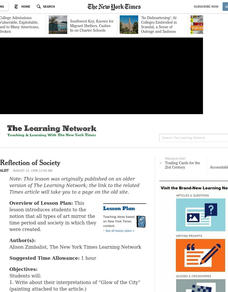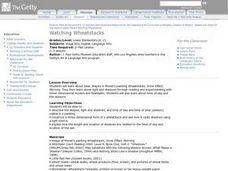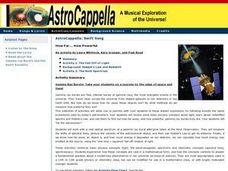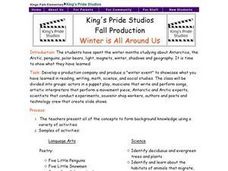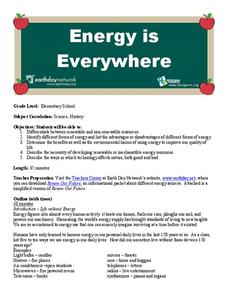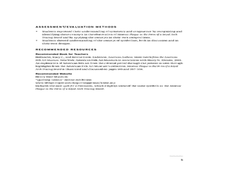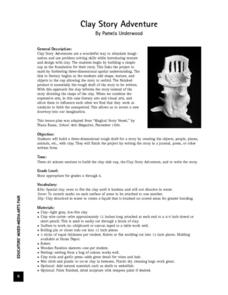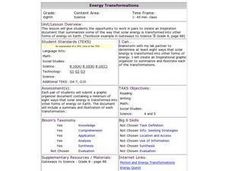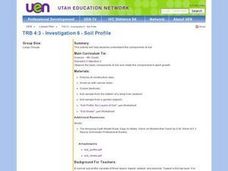Curated OER
Electromagnetic Radiation
Young scholars explore the nature of electromagnetic spectrum through a series of experiments. In this physics lesson, students determine how light behaves under certain circumstances. They explain how humans perceive colors.
Curated OER
Art as a Reflection of Society
Students write about their interpretations of "Glow of the City," discuss "Glow of the City" in terms of imagery, symbolism, use of shadows and light, and ways that it reflects life in the late 1920s in New York.
Curated OER
Watching Wheatstacks
Students explore basic shapes in Monet's paintings Wheatstacks, Snow Effect and Morning. They study about light and shadows through reading and experimenting with three-dimensional models and flashlights.
Curated OER
How Far... How Powerfu
Students work with a real optical spectrum of a gamma ray burst afterglow taken at the Keck Observatory. They measure the shifts of spectral lines, deduce the velocity of the astronomical object, and then use Hubble's Law to get its...
Curated OER
Joyeux Noel From France
In this French Christmas reading comprehension instructional activity, students read a page long story about holiday customs in France. This is written in the form of a letter from a French child. The students then answer 5 questions...
Curated OER
Meet the Neighbors: Planets Around Nearby Stars
Students explain why a transiting planet causes a periodic dimming in the light from its parent star. They determine the radius of a planet, and its orbital distance, by analyzing data and manipulating equations. Students compare the...
Curated OER
Physical and Chemical Changes
Young scholars investigate chemical and physical changes. In this physical and chemical change lesson plan, students perform 3 experiments in the lab to observe changes in matter. They determine that no new substances are formed in...
Curated OER
Getting Down with the Alphabet
Students view magazines and discuss photographs that impacted on them. In this digital photography lesson, students use digital pictures to photograph the letters of the alphabet. Students look at lighting, framing and composition and...
Curated OER
Winter is All Around Us
Learners present what they have learned on Antartica. Students identify deciduous and evergreen trees and plants; identify and study about the habitats of animals that migrate, hibernate, and adapt; study the Aurora and Aurora Borealis...
Curated OER
REFLECTIONS OF SCIENCE
Students discover the different types of mirrors, their properties and some of their applications. They have already been introduced to some of the properties of light and have already experienced some of the different types of mirrors...
Curated OER
Greenewables
Students form expert engineering teams working for the (fictional) alternative energy consulting firm, Greenewables, Inc. Each team specializes in a form of renewable energy used to generate electrical power: passive solar, solar...
Curated OER
Energy is Everywhere
Young scholars differentiate between renewable and non-renewable resources and identify the different forms of energy and list the advantages or disadvantages of different forms of energy. They also determine the benefits as well as the...
Curated OER
Symmetry and Symbols
Students identify symmetrical and congruent elements in folk art. In this art and geometry instructional activity, students examine pictures of Masonic Plaque in the Form of a Royal Arch Tracing Board for evidence of congruent and...
Curated OER
Strange Sounds
Students investigate sound as a form of energy. In this energy, forces, and sound lesson plan, students explore how different sounds may be made as they make a variety of materials vibrate. Students observe the effects of vibrations and...
Curated OER
Professor Profile looks over the horizon
Students are introduced to the differences that exist in soil properties with depth. They are introduced to the factors that influence a soil's development (soil forming factors). Pupils are introduced to the impact of soil of soil...
Curated OER
Habitats
Young scholars complete food chains for organisms in three environments. They use copies of the Habitat worksheet. Students review the food chain terms with the teacher. They research related food chains, and interlink these to form a...
Curated OER
Contructions and Conjectures
Students make constructions and conjectures. In this geometry lesson, students construct right, acute and obtuse angles using a straight edge and a protractor. They investigate parallel lines and the angles formed by the angles.
Curated OER
Clay Story Adventure
Students build three-dimensional rough draft for a story by creating objects, people, places, animals, etc., with clay, and write story in a journal, poem, or other written form.
Curated OER
Baked Polymer Clay 3D People Portraits
Students discuss methods of building forms with clay (ball and variations, snake, flat sheets). They draw a stick figure of what their sculpture may look like, including correct figure proportion.
Curated OER
Lemon Batteries Revised
Fifth graders investigate how chemical energy in food and batteries is potential or stored energy. They discuss how batteries function, and create a class list of different forms of energy. Students then create a lemon battery that...
Curated OER
Energy Transformations
Students investigate energy transformation in the form of wind energy. They read a handout, answer questions, identify points in an energy system where transformations occur, and build a wind turbine.
Curated OER
Something Fishy Going On
Students create a video animation of how Swimmy gathered his fish friends together to form a great big fish that would frighten the predator tuna away. In art class each child create a small red fish which gets displayed in the ocean...
Curated OER
How Hot Is Hot In Namib?
Students research and demonstrate the temperatures of the Namibian Desert. They watch and discuss a video, conduct an experiment to demonstrate the desert temperatures, record their results in the form of a graph, and compare/contrast...
Curated OER
Investigation 6 - Soil Profile
Fourth graders study the components of soil. They observe the basic components of soil and relate the components to plant growth. They record color, texture, and kinds of materials on their profile log (light color, denser, grittier -...

